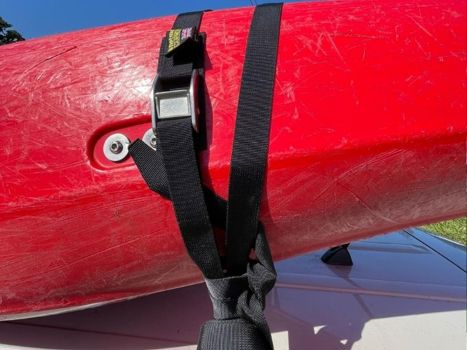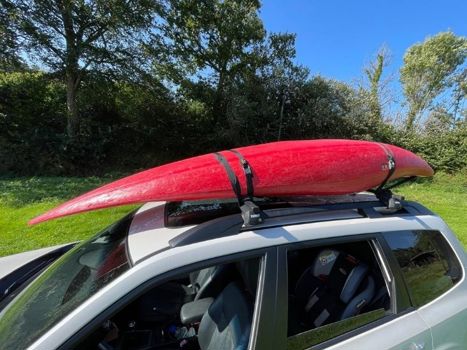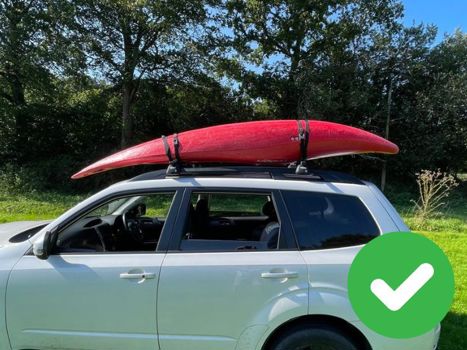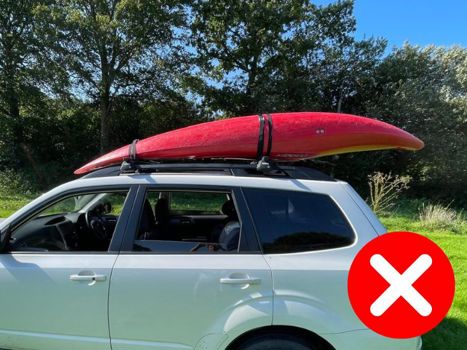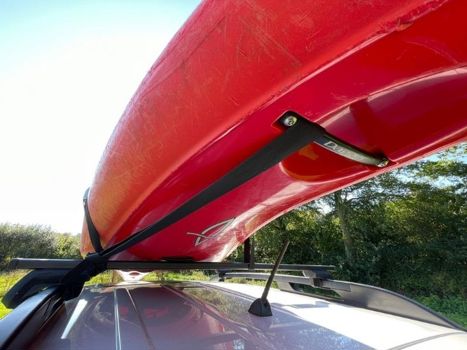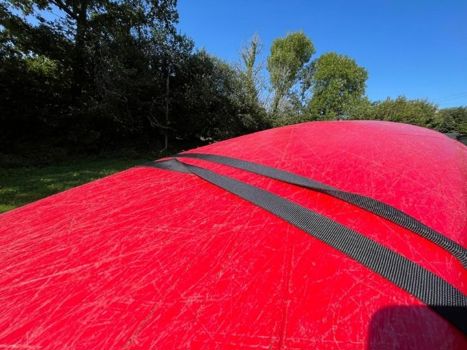Transporting kayaks and Sit on Top’s can be tricky, and with the summer season in full swing, lots of us are heading out with craft loaded high on our roof’s. Here are our top tips for safely loading kayaks and Sit on Tops onto a roof rack.
Get yourself some proper straps!
The old lengths of rope you’ve had hanging around in your car boot, for the last however long, or the ratchet straps you were given for Christmas 10 years ago by your wacky uncle, will both do the job of tying down your amazing new kayak! However, for a few pounds we suggest you get yourself a good set of cam straps.
These will make securing your new boat to the roof so much easier, and if it’s easy, it means you're going to get out on the water more!
Cam straps come in a range of lengths, in general 3.5m straps are great for loading one kayak on the roof, 4.5m will do two nicely. If you have three or more craft or open canoes something around 5m + will be what to go for. Simply loop around the bars either side of the kayak, Sit on Top, slide the buckle into the right place, put the other end through the buckle and pull tight. Any spare strap you have, wrap around and securely tie off.
Cam straps fasten automatically and are easy to undo!
How to Place your boat
Kayaks Sit on Tops & canoes can be odd shapes, and you want to aim to position the widest part of your boat between your two roof bars. When you then position the straps up and over the boat or boats and tighten then down it “should be” impossible for the boat to move forward or backwards.
If you tie the boat on with the widest part forward, or backward of the straps it highly likely the boat will work its way free, and the consequences of that aren’t great.
Uprights
If you’re going to be transporting more than one boat, most of the time then a set of upright bars will make loading your roof much easier, the bars themselves come in a wide array of fixed or folding bars, but all essentially allow you secure a boat on its side rather than flat to your roof bars. This system is nice and stable, and most cars will be able to fit up to four kayaks to a roof rack with ease.
(pic uprights with 4 boats on a roof)
J Bars and V Bars
Some kayaks such as sea kayaks or racing kayaks become very narrow at the ends and this makes them very hard to secure to your roof bars. If your sea or racing kayaks are also made from composite materials, they can be prone to damage if compressed.
J Bars and V Bars will cradle your precious sea or racing kayak, increase the contact area, spread the load, and hold them firmly in place on their side in the case of J Bars or flat if using V Bars
Padding on your roof bars
Always a sensible thing to consider! In either the form of a shop brought roof rack pad, or simply some foam pipe lagging. The foam will help to protect your boats from damage on hard roof bars and will increase the friction between the boats and hard roof bars, helping to hold them much more securely in place.
A few last top tips
· Try and pick up a handle or security point. As an extra measure to stop your boat from moving while in transit, if possible, pass the strap through a handle or security point, this will prevent the boat from moving forward or backwards if the staps loosen. If possible and if your strap is long enough, pass the strap around the roof bar once and then tie off to an end carry handle.
· Add a twist, that annoying buzz when you hit 70 on the motorway? The wobbles in the air flow over your straps have reached their resonant frequency, and they will not stop making that annoying sound until you leave the motorway or tighten all your boats at the next available stop. You can however prevent this by putting a twist or two into the strap across the top of the kayaks, or wherever else it bridges a gap. The twist breaks up the flow of air and kills the noise. Try it, it really works!
· Long loads, if you’re carrying touring boats or sea boats, racing boats or Canoes you’ll more than likely have an overhang at the front & rear of your vehicle. As an extra precaution you may want to tie the front and/or rear ends of your boats to your car’s towing eye’s. This will stop the kayaks or canoes bow or stern from lifting or bouncing excessively during the journey to the water. If the overhang extends more than one metre to the rear (but less than two) then you will need to make it clearly visible by attaching something bright and obvious to the end. A brightly coloured empty dry bay or high vis jacket works perfectly.
With these simple points taken into consideration hopefully loading your boat / boats or canoe to your roof won’t seem too daunting. Just remember your also going to want to slowdown a touch with the extra load on your roof for safety and remember as the driver you are responsible for the load on your roof! Your mate may seem like they know what they are doing but always check their work. If it does come off, you are the one that’s taking the rap.
But with that said, get the boats on the roof and go and have some fun on the water!
